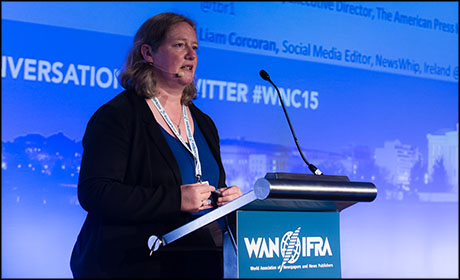
The introduction of Facebook Instant Articles divided the news industry into those worried about its impact on journalism, and those concerned about what might happen if they did not get involved.
However, Instant Articles are just the latest example of how social platforms are stepping in to fill the gap created by the rapidly evolving mobile world and an industry traditionally slow to adopt new technologies.
Emily Bell, director of the Tow Center for Digital Journalism, told delegates at this week's World News Media Congress in Washington DC, that "the free press, in as much as it still exists, is no longer owned by publishers. It's owned by platform companies".
A recently published Pew report shows six in 10 millennials say they get political news from Facebook every week, while 30 per cent of adults in America say they get news from Facebook, followed by YouTube (10 per cent) and Twitter (eight per cent).
Bell also cited Snapchat, Instagram and WhatsApp as other social platforms that have become influential in the news landscape. And the change is happening fast.
"Even within the last six months, we've seen this move, this paradigm shift, for publishers has been much quicker than we thought," she said.
Snapchat Discover launched at the start of this year as a platform for news outlets to publish stories straight into the visual messaging app, attracting the likes of CNN, Vice and the Daily Mail.Losing control of distribution is a really significant change for the journalism industryEmily Bell, Tow Center for Digital Journalism
More recently, Facebook Instant Articles now allow publishers to upload interactive stories directly into Facebook.
"What was really amazing about Facebook Instant Articles was how it sort of focused and electrified every news organisation I spoke to, from the smallest local publishers to the largest international publishers," said Bell.
Of the nine publishers selected for the launch of Instant Articles, she believes the New York Times is "probably the most surprising... because it's perhaps seen as in the vanguard... it had the strength, the power, to compete".
Challenges
While partnerships with technology companies present new opportunities for publishers, they are of course not without potential problems.
While Bell noted that the description of Facebook's newsfeed algorithm is "relatively benign" – claiming to present posts to users depending on who posted it, what type of post it is and the number of interactions it received – details of how the algorithm actually works are not known.
"Unlike any other period in regulated media history, we're potentially going into a time where that relationship, being us producing something and it being published to the outside world, is completely unknowable both to citizens and publishers," she said.
This means publishers risk "losing the paths" between stories and readers, as well as giving up control of their data and revenue streams.
Although Bell used Facebook as an example, she noted that these problems could easily apply to other platforms such as Snapchat and WhatsApp.
"Losing control of distribution is a really significant change for the journalism industry," she said.
Another issue with this model, of course, is that the cost of producing stories falls to the news outlet while the social platform gets the lion's share of the revenue.
However, Bell believes this is inevitable unless news outlets are able to harness new technology at the same pace and level as their new social competitors.
"Until we've got something that competes with [tech companies], we are always going to be in a position of weakness," she said.

Emily Bell addressing delegates at the World News Media Congress (credit: Wan-Ifra)
Opportunities
Partnering with social platforms such as Facebook and Snapchat allows publishers to reach audiences "of a size and type that simply would not be possible to reach in an analogue world," explained Bell.
When these apps have become the dominant media platform for younger audiences, news outlets risk missing out on a huge swathe of the under-30 demographic if they do not embrace them.
Journalists and editors also have a card up their sleeves that technology platforms desperately need: knowledge of publishing frameworks, risks and ethical issues.
"It is no longer possible [for social platforms] to say 'we are just a platform'," said Bell. "It's become impossible to sustain the argument that says we have no responsibility to people who upload content, and we have no responsibility to people who are affected by it."
As an example, she highlighted a statement made by Twitter's chief executive Dick Costolo last year announcing that accounts posting images or video of ISIS-led beheadings would be shut down.
"Perhaps the good news for journalism is if you have three or four giant, really significant players competing to own the content... journalism becomes one of the value propositions within that competition, and for the first time in a decade we have some leverage over that market," said Bell.
On the subject of whether publishers should embrace or reject new technology partnerships, Bell said it was important to be able to do both.
"We have to embrace the current opportunities of the platform, but we also have to maintain a level of independence."
One way this can be achieved, she said, is for news outlets to continue to experiment and invest in new technology to develop new business models better adapted to competing in the rapidly developing digital market.
Free daily newsletter
If you like our news and feature articles, you can sign up to receive our free daily (Mon-Fri) email newsletter (mobile friendly).









